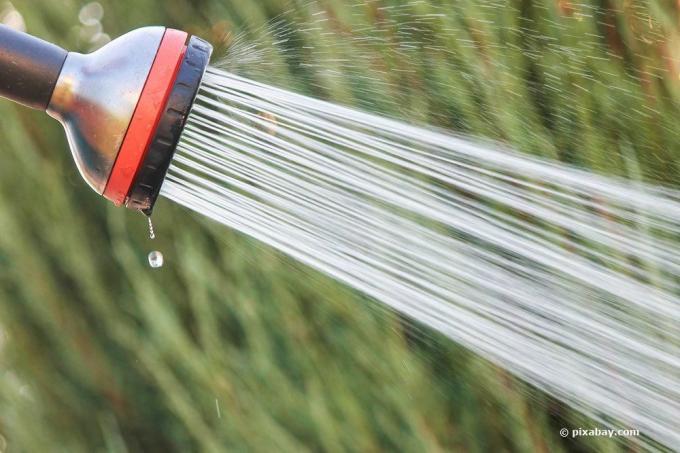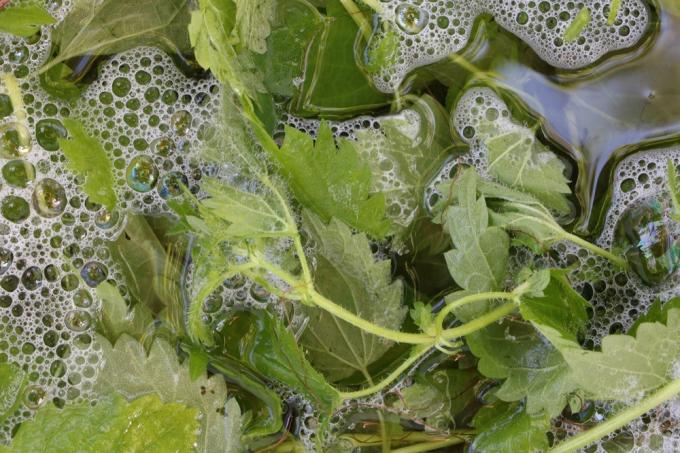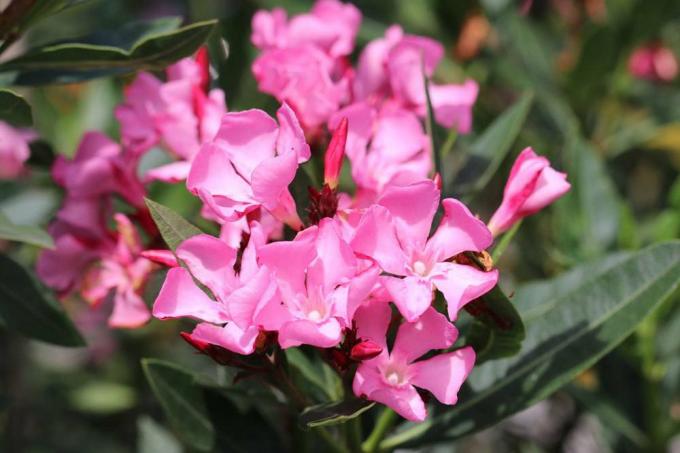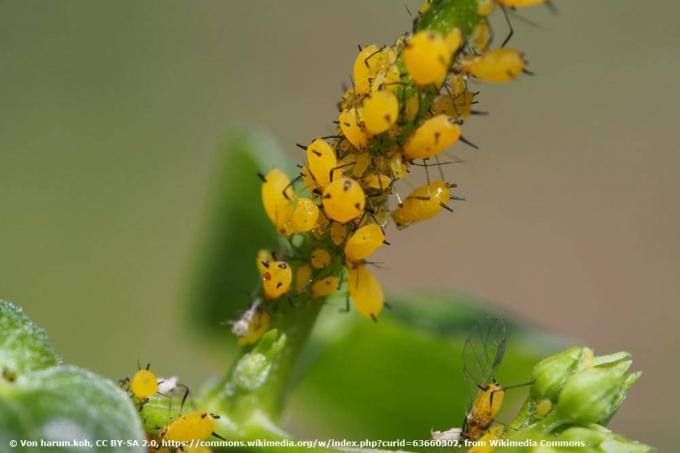
table of contents
- Yellow lice
- Multiplication
- Eating behavior
- Damage image
- Fight yellow lice
- Natural enemies
- Home remedies
- Water jet
- Collecting
- Soapy solution
- Rapeseed oil and water mixture
- Nettle stock and nettle manure
- Tobacco brew
- Milk-water mixture
Of the oleander, botanically Nerium oleander, is not only very popular with humans, but unfortunately also with small, yellow lice. Because for them, the Mediterranean beauty is the preferred host plant. And once a yellow louse has been discovered, it only takes a short time for a whole colony to emerge. To prevent the plague, a daily check is part of the care of the plant. If you have discovered an infestation, action must be taken quickly, preferably with the following home remedies.
Yellow lice
The yellow lice, which prefer to nest in the oleander, are not a special type of lice, but rather Aphids. However, the yellow aphids have specialized in the oleander and other plants from the dog poison family (Apocynaceae), to which Nerium oleander also belongs.
The yellow aphid, also known as the oleander aphid, is round and one to two millimeters in size. Her body is dark yellow and her feet are black.
tip: Aphids form so-called. Aphid colonies, but they can also occur individually.
Multiplication
In aphids there are only females. Their reproduction takes place through the so-called. Maiden generation (Parthenogesis). In other words, you clone simply, whereby the animals do not lay eggs, but give birth to their offspring alive. The generation of offspring is described by experts as explosive, because the lice have often colonized most of the plant within a few days. If there is an overpopulation or if the aphid colony is disturbed, they hit insects off an alarm fragrance. This causes the yellow aphid to immediately start producing winged offspring. These then leave the colony and look for a new host plant.
Eating behavior
Yellow aphids, like green and black aphids, feed on the sap of the plant. They basically suck up the plant. They press for this with theirs Piercing bristles deeply into the plant tissue and suck the sap from all parts of the plants, even from the roots. The yellow lice need the protein from the plant sap for their nutrition; they cannot use the carbohydrates contained in the sap. These are excreted by the louse and leave a sticky substance on the plant, the so-called. Honeydew.
Damage image
At the beginning of the infestation, aphids settle on the undersides of the leaves and the young parts of the plant, i.e. on leaf shoots and young buds. Later, however, the lice also sit on the older, not lignified parts of the plant. The excreted honeydew first covers the shoot tips and leaf axes, but as the colony grows it also extends to the other parts of the plant. The damage also includes:
- Discoloration of the leaves
- Curling up the leaves
- Drive anomalies
- deformed flowers
It is true that the aphid infestation, if not controlled, ultimately leads to the death of the plant, but the danger caused by the honeydew is often much greater. Because honeydew is a sugary solution that serves as a breeding ground for viruses and fungi, such as dangerous ones Sooty fungus. For this reason, honeydew and the associated virus and / or fungal attack are seen by many experts as a more deadly threat to Nerium oleander than the yellow aphids themselves. You can recognize the infestation with fungi or viruses by the dark brown or black color of the honeydew.

tip: If ants show up on the oleander, this is not a good sign. Because they feed on honeydew and in return protect the colony from predators.
Fight yellow lice
Natural enemies
If you hope for the help of the natural enemies of aphids with yellow aphids, you will unfortunately have to be disappointed, because the yellow aphids have Defense Mechanisms developed against their predators. On the one hand, it's their yellow color, which is supposed to signal danger. On the other hand, and this is the more effective defense, they absorb the highly toxic cardiac glycoside oleandrin with the plant sap. Depending on the concentration, this poison leads to deformities or disturbed behavior in predators.
Home remedies
Yellow aphids are an annoying plague that poses many deadly threats to the oleander, so they must be controlled early. In addition to toxic pesticides, there are a number of home remedies that you can use to fight the lice. However, in order for them to work effectively, you need to use the funds more often.
tip: When it comes to combating aphids, the earlier the better. If individual parts of Nerium oleander are already contaminated with the yellow lice, or if a fungus has already settled, then you should cut off the infected parts of the plant generously.
Water jet
The targeted hosing down with a hard jet of water has two effects. On the one hand you clean the plant from the honeydew and on the other hand you remove the yellow aphids from the plant. To prevent the lice from falling on other parts of the plant, you should hold a pot or bucket under the sprayed areas.

tip: Before hosing down, cover the substrate with a film so that the lice do not fall on the ground.
Collecting
If you find only a few yellow lice on the oleander after careful examination, you can crush them with your hand or a damp cloth. Remember to wipe off the honeydew immediately.
tip: When using this method, you should definitely wear gardening gloves to protect the skin from irritation with oleandrin.
To make sure that the yellow louse infestation is really contained, you should treat the oleander with other household remedies to get rid of the plague
Soapy solution
Splashing with soapy water is that First aid measure if there is an infestation of yellow lice. A solution of water with soft soap, curd soap or detergent is suitable for the soapy water. To do this, add a teaspoon of soap to a liter of water. Mix the two components carefully and then pour the solution into a spray bottle. After spraying the infected areas with the soapy solution, the oleander lice can be easily removed. In any case, repeat the procedure in the next two to three days.

tip: Since the soapy water is not exactly healthy for the oleander, you should make sure that as little as possible of it gets into the soil during treatment. Therefore, you should cover the soil with plastic.
Rapeseed oil and water mixture
For the rapeseed oil-water mixture, add 300 milliliters of rapeseed oil to one liter of water. Shake the mixture well and use it to spray the plant. The aphids suffocate due to the oil film in the water.
tip: Compared to soapy water, the rapeseed oil-water mixture is healthier for the oleander.
Nettle stock and nettle manure
Nettle stock
You can use dried or fresh nettles to make nettle stock. There are 100 grams of nettles for every liter of water. With cold water pull-outs, let the nettles soak in cold (rain) water for 12 to 48 hours, with hot water pull-outs, the nettles must first be soaked in water for 24 hours. Then the brew with the leaves must simmer gently for about 30 minutes. When the brew is ready, sieve off the solid components of both production methods. While the brew can be used undiluted immediately with cold water pull-outs, with hot water pull-out the brew must be cooled down and diluted. The mixing ratio is 1: 5 or 1:10.
tip: Nettle stock may only be used if the fermentation process has not yet started, otherwise the stock will burn the leaves.
For the treatment, fill the nettle stock into a watering can with a shower attachment and use it to pour off the oleander. The undersides of the leaves are sprayed with a spray bottle. To prevent the leaves from burning, you should not use the nettle stock in direct sunlight. For effective control, the process must be repeated for at least three days. Once all the aphids have disappeared, the nettle stock should be used a few more times as a preventive and final measure. In this way you can be sure that the pests do not return, as the brew does not kill the lice, but drives them away.
Nettle manure
Nettle manure is that fermented Form of nettle stock. It occurs when the mixture has stood in a warm and sunny place for at least two weeks. The fermentation process is complete when you no longer see any foam when you stir it every day. For the control of yellow aphids, the manure must be diluted in a ratio of 1:10.

Tobacco brew
For a tobacco stock you need 50 grams of tobacco from the kiosk or from leftover cigarettes and one liter of water. It is best to let the mixture steep for a day and then wipe it through a cloth. For the treatment, spray the oleander with the tobacco stock for several days.
tip: Nettle and tobacco and can also be added to the irrigation water. In this way, the brew reaches the upper parts of the plant via the roots, and it is absorbed by the oleander lice with the plant sap. That's why it doesn't matter if the brew drips onto the substrate when spraying.
Milk-water mixture
A mixture of milk and water not only drives away the yellow lice, but is also supposed to kill them. For the treatment, spray a mixture of 100 milliliters of milk to 200 milliliters of water on the oleander. As with all home remedies, you should carry out the procedure over several days.





